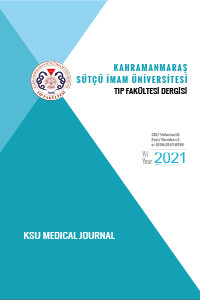Saf Duktal Karsinoma İn situ’lu Hastalarda Adjuvan Radyoterapi Etkinliğinin Farklı Değişkenlere Göre Değerlendirilmesi
Öz
Introduction: Ductal carcinoma in situ is a non-invasive pathology of breast cancer. Pure ductal carcinoma in situ is extremely rare, although it is often accompanied by invasive breast cancers.
Materials and Methods:The study included 27 patients who applied to the Adana City Training and Research Hospital Radiation Oncology outpatient clinic and received adjuvant radiotherapy with a diagnosis of pure ductal carcinoma in situ.
Results:The mean age of the patients was 45.33 in the premenopausal period and 59.83 in the postmenopausal period, and a statistically significant result was obtained when the age of both groups was compared (p = 0.001). Age and tumor diameter (38.8%) was assessed statistically significant (p <0.05). it can be stated that the tumor diameter tends to increase with increasing age.
Conclusion: Age, tumor size, receptor status, operation margin, histopathological grade, multifocality and adjuvant treatments are effective on local recurrens and survival in ductal carcinoma in situ patients. Patients diagnosed with ductal carcinoma in situ receive adjuvant radiotheray after breast conserving surgery, reducing the risk of local recurrens.
Anahtar Kelimeler
ductal carcinoma in situ adjuvant radiotherapy local recurrence breast cancer
Kaynakça
- 1. Groen EJ, Elshof LH, Visser LL. Finding the balance between over- and under-treatment of ductalcarcinoma in situ (DCIS). The Breast 2017;31:274-28.
- 2. Lakhani SR, Ellis IO, Schnitt SJ, Tan PH, Van de Vijver MJ. WHO Classification of Tumours of the Breast, Fourth Edition. Lyon: IARC Press; 2012. 2.
Evaluation of Adjuvant Radiotherapy Efficacy in Pure Ductal Carcinoma In situ Patients According to Different Variables
Öz
Introduction: Ductal carcinoma in situ is a non-invasive pathology of breast cancer. Pure ductal carcinoma in situ is extremely rare, although it is often accompanied by invasive breast cancers.
Materials and Methods:The study included 27 patients who applied to the Adana City Training and Research Hospital Radiation Oncology outpatient clinic and received adjuvant radiotherapy with a diagnosis of pure ductal carcinoma in situ.
Results:The mean age of the patients was 45.33 in the premenopausal period and 59.83 in the postmenopausal period, and a statistically significant result was obtained when the age of both groups was compared (p = 0.001). Age and tumor diameter (38.8%) was assessed statistically significant (p <0.05). it can be stated that the tumor diameter tends to increase with increasing age.
Conclusion: Age, tumor size, receptor status, operation margin, histopathological grade, multifocality and adjuvant treatments are effective on local recurrens and survival in ductal carcinoma in situ patients. Patients diagnosed with ductal carcinoma in situ receive adjuvant radiotheray after breast conserving surgery, reducing the risk of local recurrens.
Anahtar Kelimeler
ductal carcinoma in situ adjuvant radiotherapy local recurrence breast cancer
Kaynakça
- 1. Groen EJ, Elshof LH, Visser LL. Finding the balance between over- and under-treatment of ductalcarcinoma in situ (DCIS). The Breast 2017;31:274-28.
- 2. Lakhani SR, Ellis IO, Schnitt SJ, Tan PH, Van de Vijver MJ. WHO Classification of Tumours of the Breast, Fourth Edition. Lyon: IARC Press; 2012. 2.
Ayrıntılar
| Birincil Dil | İngilizce |
|---|---|
| Konular | Sağlık Kurumları Yönetimi |
| Bölüm | Araştırma Makaleleri |
| Yazarlar | |
| Yayımlanma Tarihi | 1 Kasım 2021 |
| Gönderilme Tarihi | 20 Kasım 2020 |
| Kabul Tarihi | 17 Ocak 2021 |
| Yayımlandığı Sayı | Yıl 2021 Cilt: 16 Sayı: 3 |

